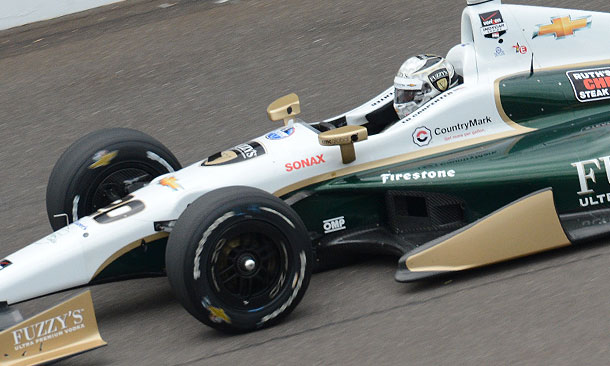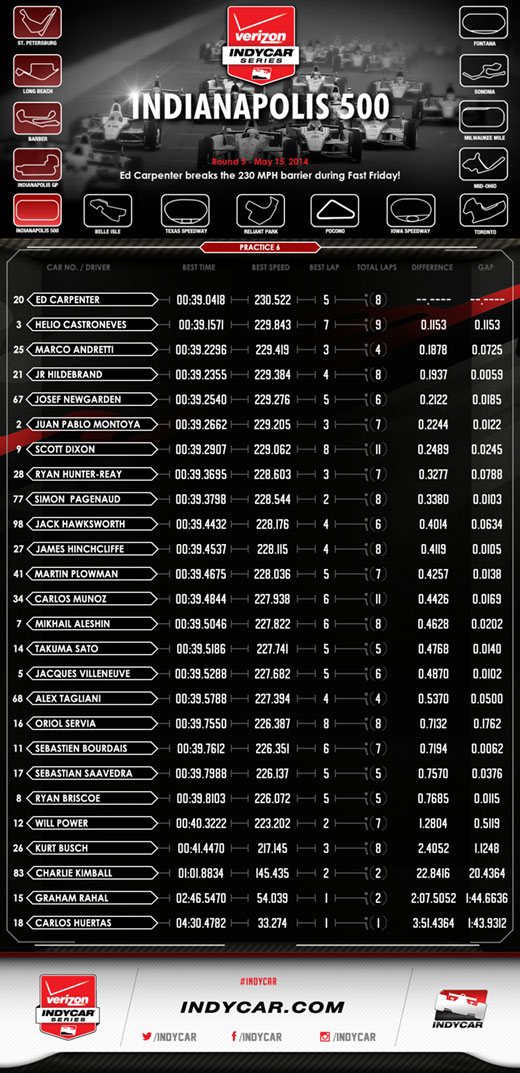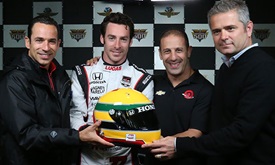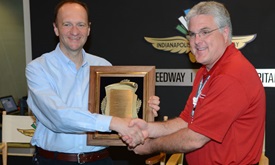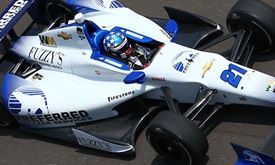Coming straight at you: 230 mph pole average?
MAY 16, 2014
Will Power threw out the notion early this month that a four-lap average of 230 mph in qualifications May 17-18 for the Indianapolis 500 Mile Race was approachable with favorable conditions.
Ed Carpenter’s lap of 230.522 mph less than 12 minutes into the “Fast Friday” session on the 2.5-mile Indianapolis Motor Speedway oval gave credence to the Team Penske driver’s hypothesis. Carpenter’s calling card was the fastest lap speed in practice since 2003 by Scott Dixon, who laid down a 233 mph-plus lap on Pole Day morning. His section speed from the Yard of Bricks start-finish line to the timing beacon in Turn 1 on Lap 5 was 236.954 mph.
“The car is definitely up to speed this year,” said Carpenter, who earned the $10,000 F.E. Harding Asphalt Companies Fastest Lap Award for the brief work. “When it comes to predicting the pole, I think a lot of it will be figuring out what the weather is. If it warms up enough and the air gets a little thinner, certainly I think 230s are realistic, even up to 232 and 233. It's great to think that in a couple of years we'll be going after the track record.”
Click it: Qualifications order || Morning practice groups || May 16 practice results
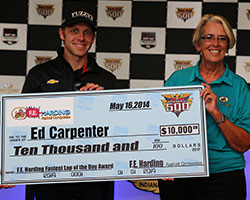 The session was halted after 19 minutes because of rain that remained in the area to force cancellation of the remaining 90 minutes. Ninety total minutes of practice May 17, beginning at 8 a.m. (ET) precedes qualifying.
The session was halted after 19 minutes because of rain that remained in the area to force cancellation of the remaining 90 minutes. Ninety total minutes of practice May 17, beginning at 8 a.m. (ET) precedes qualifying.
The first round of qualifications is from 11 a.m.-5:50 p.m. (ABC coverage from 4-6 p.m. ET), with starting positions, including the Verizon P1 Award, determined May 18 (ABC coverage from 1-3 p.m. ET that will feature the Fast Nine Shootout for the pole).
Four different teams were represented in the top five, seven entries posted a lap speed above 229 mph, and 10 more bettered the previous month’s best of 227.166 mph set a day earlier by three-time Indianapolis 500 winner Helio Castroneves in the No. 3 Pennzoil Ultra Platinum Team Penske car.
Castroneves was second fast (229.843 mph) in the session. Marco Andretti was third (229.419) in the No. 25 Snapple car for Andretti Autosport, while Carpenter’s teammate, JR Hildebrand, was fourth (229.384) in the No. 21 Preferred Freezer Services entry and Josef Newgarden of Sarah Fisher Hartman Racing was fifth (229.276).
Carpenter earned the Verizon P1 Award last May with a four-lap average speed of 228.762 mph in the No. 20 Fuzzy’s Ultra Premium Vodka car with a top speed of 229.347 mph on Lap 1. It was the best four-lap average since 2006 when Sam Hornish Jr. won the pole with a four-lap average of 228.985 mph.
Click it: Procedures for the two days of qualifications
Surpassing that over 10 miles in what Carpenter has called “more stressful than the race” will depend in large part on three factors:
Ambient and track temperatures
The May 17 weather forecast is for partly cloudy skies with a high temperature of 60 degrees, with highs in the mid-60s on May 18, which could be the sweet spot Carpenter referenced for the Verizon IndyCar Series cars.
“The air density -- humidity and ambient air temp -- has a lot to do with how much downforce versus drag the car is actually making,” said Hildedbrand, the Indy 500 runner-up in 2011 as a rookie. “That’s where your speed comes from and you don’t want to overshoot that by much one way or the other when you’re qualifying. The added variability adds to the stress and what to expect, and it adds to the out-of-car prep with the engineer that a driver needs.”
Team engineers are continuously monitoring and logging ambient temperature, track temperature, ambient pressure, humidity, and wind direction/speed and making adjustments as necessary to optimize the car’s set-up.
Firestone tires and grip
Firestone has supplied a new-for-2014 left and right tire compound to provide “a touch more” grip along with a new construction of the left-rear for more rear security, according to Cara Adams, Firestone's Senior Project Engineer for Race Tire Development.
Cooler track temperatures are generally better for tire wear and maintaining a higher grip level over a longer period of time, but there is a disadvantage in that it takes longer to generate tire temperature and get to the optimum running temperature.
Entries receive one warm-up lap before their qualifying attempt is on the clock.
Engine homologation
Some components of the Chevrolet and Honda 2.2-liter, twin-turbocharged V6 engines are fixed for the duration of the engine regulations and others are open for continuous development – such as pistons and valve springs -- and others can be changed every two years. In the engine rules’ third year, components that have changed since 2013 include camshafts, the plenum, intake ports and exhaust ports – detailed features within the existing casting – the fuel system.
Developments, in conjunction with the new BorgWarner twin-turbocharger, have led to increases in power.
“There’s a lot of potential from being able to rework (the areas open for development) within the framework of the rules,” said Mark Crawford, principal engineer at Honda Performance Development.
The role of the BorgWarner twin-turbocharger is to increase the density of air entering the engine through increased pressure. Because the rules provide a maximum boost level (140 kPa for qualifying), the density of the air entering the engine is consistent regardless of ambient temperature or pressure because the turbos are maintaining this consistent boost level.
Also, the twin-turbocharged Chevrolet and Honda engines run better with a cooler air inlet charge because it increases the air density (more oxygen available for a given volume of air).
Additionally, the boost level has been increased from 130 kPa to 140 kPa for qualifications. The change in pressure adds about a 40 horsepower boost to the engines. It will return to 130 kPa for final practice on Coors Light Carb Day on May 23 and the race.
Click to download the hi-res Infographic










